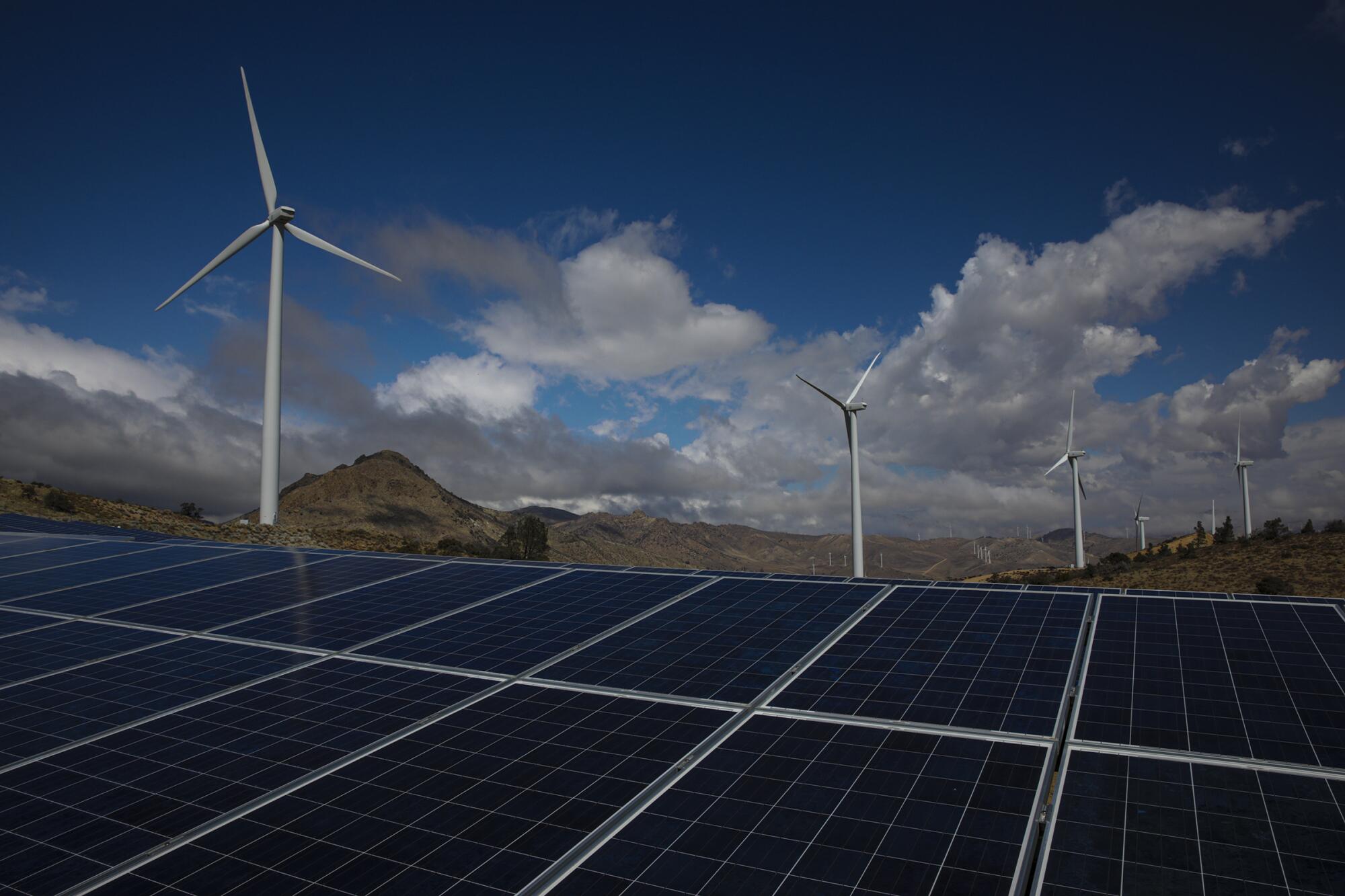
California is poised to fail to meet its ambitious greenhouse gas reduction goals by the end of the decade unless it can triple its efforts to reduce carbon emissions statewide, according to a critical new report.
Although the state has pledged to slash planet-warming emissions by 40% of 1990 levels by 2030, the state is not on track to meet that commitment, according to an analysis by the nonprofit group Next 10 and Beacon Economics, an L.A.-based consulting firm.
California has long been a leader in emissions control, and the new report has faced pushback from state officials who say they are much further along in hitting the goals than the report authors believe.
The report said that based on the most recent data available from the state, emissions have fallen just 11.5% below those of 1990.
âPolicymakers have set this goal and now need to make difficult decisions about trade-offs if they want to meet it,â said Stafford Nichols, research manager at Beacon.
New research warns of a possible collapse in Atlantic Ocean currents due to climate change. That could fundamentally alter global weather patterns.
While pollution plummeted after stay-at-home orders were issued during the pandemic in 2020, the stateâs carbon emissions increased by 3.4% the following year, according to the analysis.
That will make it harder to meet the goal set by state lawmakers in a 2016 bill known as SB 32.
Based on the trajectory of reductions since 2010, California wonât attain the mandated goal until 2047, according to report authors.
The rise in 2021 emissions was driven by an increase in electric power generation, the report said. Because of the drought that year, the state used less hydropower and compensated with more energy from natural gas-fueled power plants, Nichols said.
That year there was also a 7.4% jump in emissions from transportation as the pandemic restrictions were loosened. Not only did Californians get back in their cars in 2021, but more people avoided public transit. Ridership in 2022 was 40% below what it was before the pandemic, the researchers found, setting back the stateâs progress in reducing passenger vehicle emissions.
The report, called the California Green Innovation Index, provides an annual snapshot of the stateâs decarbonization efforts. Nichols said researchers had become frustrated as state officials have taken longer to release emissions data. The numbers from 2021 were released just a couple months ago, he said.
He said calculations using more recent data would likely result in the need for an even quicker pace of carbon reductions to meet the 2030 goal.
The chairwoman of the California Air Resources Board â the agency tasked with overseeing greenhouse gas reductions â has taken issue with the studyâs conclusion and insists that California is on track to meet its goals.
âOur preliminary data show that in 2022 the emissions started to move back down,â said Liane Randolph, who was appointed to lead the board by Gov. Gavin Newsom.
The first ice-free days of the Arctic Ocean could occur as soon as the 2020s or 2030s â as many as 10 years earlier than previous projections.
Randolph pointed out that even though the California economy rebounded in 2021 by 8%, emissions increased by just 3.4%.
âTo me, that shows our programs are working,â she said. âIt shows that weâre not only growing our economy, but weâre growing a fundamentally cleaner economy.â
Added Alex Stack, a spokesperson for Newsom: âWe donât shy away from ambitious goals, because thatâs what itâll take to make a difference. Our administration and CARB are taking the actions necessary to hit these goals.â
Details in the new report show how far the state has yet to go. The researchers calculated that the state had reduced emissions an average of 1.5% annually between 2010 and 2021. To reach the 2030 goal it would now have to reduce emissions by 4.6% a year.
California has reduced emissions by more than 4% annually only twice in the last two decades, and both years â 2009 and 2020 â were times of economic recession.
Despite the reportâs prognosis, authors acknowledged that California is the third-most carbon-efficient state, after New York and Massachusetts. Californiaâs carbon intensity is 8.8% lower than the national average, according to the report.
And while emissions from electricity production rose in 2021, they are still down more than 40% since 2000 and 12% since 2016.
The state also met its 2025 goal of having 1.5 million zero-emission vehicles on the road two years early, although sales of electric vehicles dropped for the first time in more than a decade late last year.
âWhile California is well-positioned as a leader on climate, there are substantial obstacles to accelerating our decarbonization efforts in an equitable way that benefits all Californians,â said F. Noel Perry, Next 10âs founder. âThese are not insurmountable, but we need to act urgently.â
The U.S. Environmental Protection Agency is considering approval of Californiaâs first ever carbon storage project, to be in Kern County.
The researchers highlighted how California could eliminate emissions by finding ways to decarbonize the stateâs cement factories. That industry accounts for 2% of the stateâs emissions. Greenhouse gases from the eight plants that produced nearly all of the stateâs cement increased by 26% from 2011 to 2021.
While the California plants are marginally more efficient than the average American cement factory, they emit about 33% more pollutants than those in China and India, the report said.
The new report was not the first to detail how the state was falling short of its climate goals.
In a report released last year, the nonpartisan Legislative Analystâs Office, which advises state lawmakers, estimated that emissions had been falling an average of about 1% a year over the last decade and would need to fall 4% annually. That report said the California Air Resources Board lacked âa clear strategyâ for meeting the 2030 goal.
The agencyâs âestimated reductions are driven primarily by assumptions developed by CARB, without specifying how those assumed outcomes might be achieved,â that report said.
Toward a more sustainable California
Get Boiling Point, our newsletter exploring climate change, energy and the environment, and become part of the conversation â and the solution.
You may occasionally receive promotional content from the Los Angeles Times.










